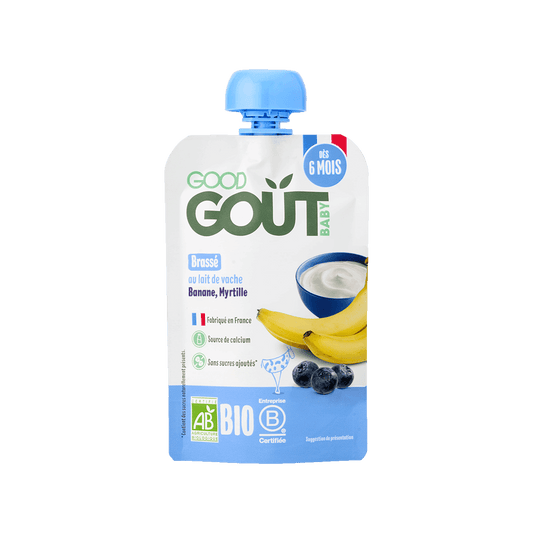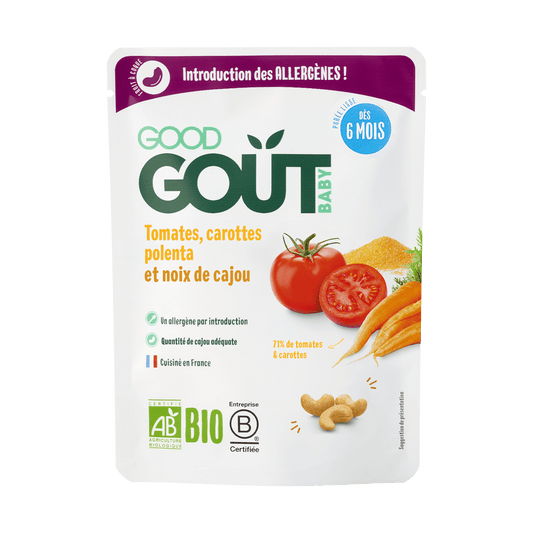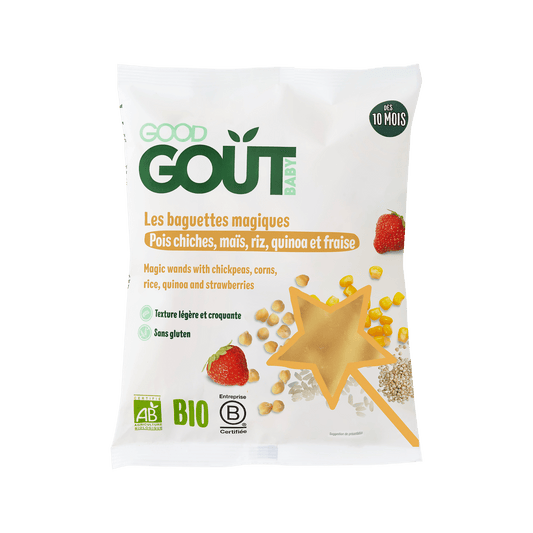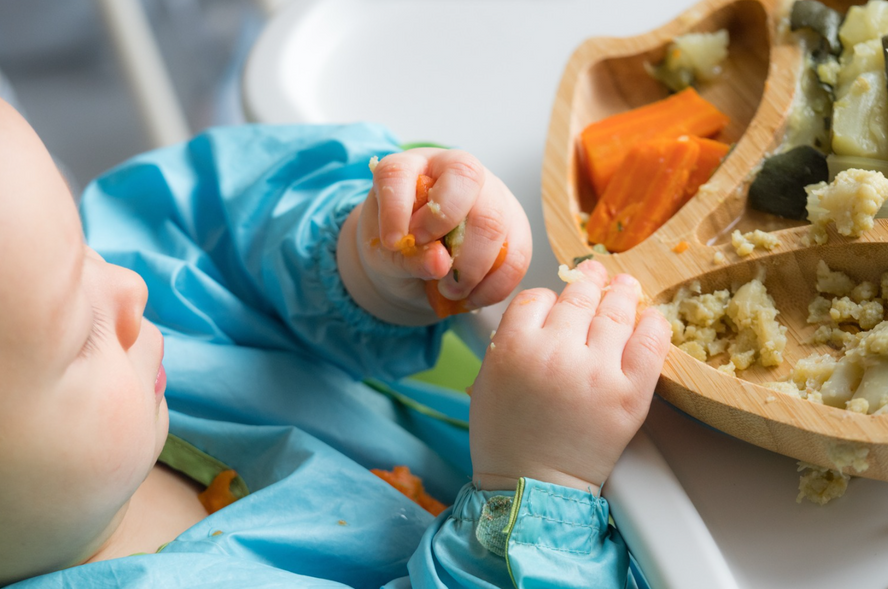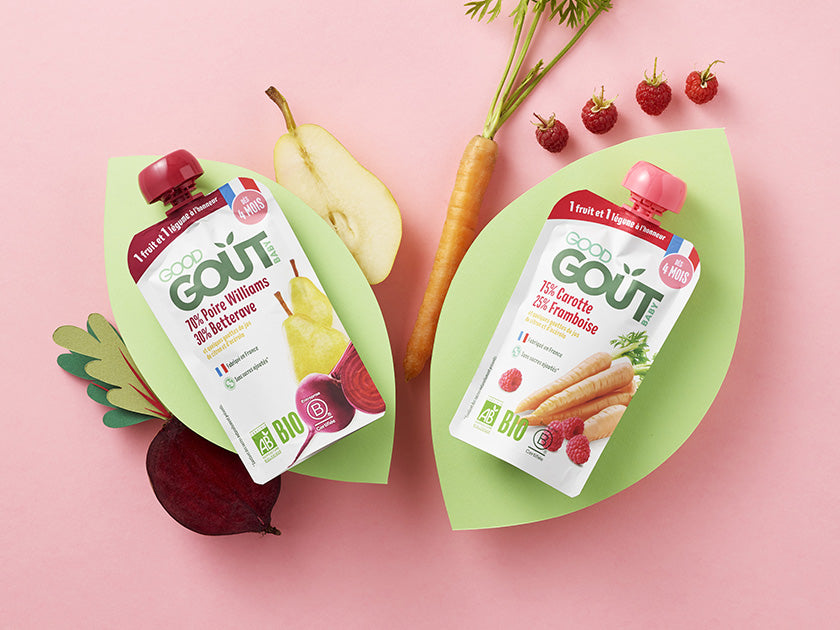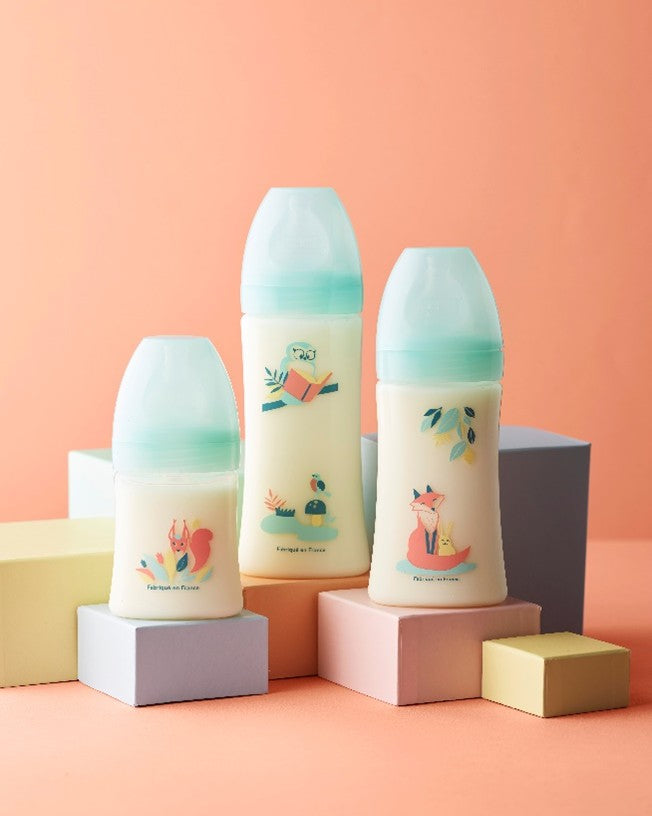With baby-led weaning (BLW), taste bud development has taken on a whole new dimension! Here's more about this practice of letting toddlers eat chunky foods on their own. Let's get started!
What is Baby-Led Weaning (BLW)?
Definition of DME
When we talk about BLW , we're actually talking about Baby-Led Weaning . In other words, it's about the spontaneous discovery of food by toddlers. No puree, no spoon: with BLW, babies observe, grab, smell, and put in their mouths food in pieces whose size and texture are adapted to their age and ability.
What are the benefits of DME?
Becoming a little taste explorer is a different way to experience weaning... And not just for your child! Among the many benefits often associated with DME, we mention 1 2 :
- the autonomy acquired by the child
- the progress observed in terms of dexterity and autonomy
- the atmosphere at the table (since everyone can eat at the same time)
- the acceptance of new tastes facilitated by the handling of food
- the awakening of taste and the pleasure of eating
What are the disadvantages?
Let's not lie to ourselves, DME is also a school of patience for children, as it is for those around them on a daily basis! Apart from the mealtimes which will tend to get longer, you will certainly witness some Olympic-style events: wrestling with crushing pieces, throwing cookies, dipping carrots into the glass of water! In short, you may sometimes struggle, but if you are motivated, you will see that the (Olympic) game is worth the effort. Finally, know that not all babies are up for DME! If this is the case for your child, don't be offended and try the experience again in a few weeks.
At what age should you start baby showering?
To begin baby-led weaning, your child must be at least 6 months old. But that's not the only criterion to consider! We'll explain everything.
Advice from experts and pediatricians
Are you interested in trying BLW with your baby? Before you get started, you'll need to make sure you tick all 3 of these boxes:
- your little one is at least 6 months old ✅
- he is healthy and developing normally for his age ✅
- he is able to remain seated in his high chair for the entire meal without assistance ✅
- he is able to grab an object, bring it to his mouth and release it ✅
- the whole family knows about DME and is ready to experience this great adventure of taste together ✅
If you have 100% positive responses, you can soon begin BLW. But if you have any doubts or questions, don't hesitate to talk to your pediatrician.
How to set up DME?
The necessary equipment
For successful DME, we advise you to have on hand:
- a high chair, suitable for infant meals from 6 months, in which your child sits comfortably while being free to move
- a large bib or smock (to avoid collateral damage)
- a little patience
- a high chair, suitable for infant meals from 6 months, in which your child sits comfortably while being free to move
- a large bib or smock (to avoid collateral damage)
- a little patience
And what about the spoon, you ask? According to the pioneers of DME, babies don't need a spoon or a fork because they use... their hands!
Meal organization
BLW means more autonomy and therefore more time spent at the table. As the National Institute of Public Health of Quebec 4 points out, babies who feed themselves generally take longer to finish their plate. If, like all parents, you sometimes find yourself in a hurry at lunch or dinner time, it's better to spoon-feed your baby before slowly resuming BLW at the next meal.
Choosing first foods
When you say DME, you say, above all, food diversification. You will therefore have to follow the precepts even if your baby is in charge! From 6 months, your child can taste almost everything! But DME or not, keep in mind that, at first, each food must be discovered individually. When it comes to cooking, keep it simple: boiled vegetables, steamed fruit, and no salt or added sugar! On the other hand, you are encouraged to add fat to each meal (rapeseed, nuts, olives, and why not, a little butter from time to time).
Vegetable side: https://www.goodgout.fr/coin-parents/quel-legume-en-premier-pour-bebe-417.html
Fruit side: https://www.goodgout.fr/coin-parents/quand-ouvrir-les-fruits-dans-l-alimentation-de-bebe-453.html
Contrary to popular belief, the size of the pieces should not be too small! Because even if your children have mini-fingers, they are not as agile as we are. The ideal is to offer food long enough so that it protrudes from their closed fist, on the principle of our Sticks . Little by little, your baby will become more and more skillful: they will then be just as comfortable with smaller pieces or other shapes.
At the same time, your baby will obviously continue to be breastfed on demand or receive bottles of infant milk.
Important notice: Breast milk is the ideal and natural food for infants.
How to ensure baby's safety during BLW?
Preventing the risk of suffocation
Baby-led weaning is a wonderful family adventure that requires constant involvement. When a baby eats (whether it's soup with a spoon or small pieces on their own), there is a risk of choking. The food you offer should have a soft texture so your child can crush it on the roof of their mouth with their tongue. Small, round, smooth, and sticky foods should also be avoided. Staying close to your baby and making sure to offer small amounts with textures and sizes appropriate for their age will help limit the risks. Be aware that some babies who feed themselves tend to gag more 5 . Generally, these babies will cough and spit out the food on their own. This reflex (called the "gag reflex") will help prevent choking.
Finally, one last little safety tip: never offer dual-texture recipes. Indeed, when it comes to chewing pieces or swallowing their purée, your baby won't make the same movements with their mouth. It's therefore better to focus on a single texture in each dish (the moral is that for "zucchini in 3 ways" in Cyril Lignac style, we'll have to wait a few more years!).
Monitoring and support
As you can see, DME is a team sport. Your role is to be both the coach, the nutritionist, and your baby's primary supporter. Take the time to explain the principle of DME, offer them a variety of foods while following the fundamentals of solidification, encourage them, and make sure they swallow well. If you have any doubts about the consistency of a food, test it yourself: the right texture is when the food crushes easily between your thumb and index finger. On the other hand, if you feel any resistance, then you will need to review the cooking.
What recipes are there for getting started with DME?
Giving you advice is good, but making everyday life even easier with special DME recipes is even better... Right?
Easy recipes for BLW
At Good Goût, we wake up every morning with the desire to simplify parents' lives. When it comes to baby-led weaning, we've come up with a variety of fun and delicious cookie and meal recipes to give your curious babies. Shapes, textures, flavors, and nutritional benefits have all been designed to make baby-led weaning a breeze.
Easy to grasp and bite into from 10 months, Tout Rond Biscuits are both fun and delicious. They also make baby-led weaning a part of snack time.
Designed to make aperitifs downright delicious, Amuse-Bouches can be given to babies from 12 months old.
Specially designed to delight the taste buds and promote fine motor skills from 12 months.
Our tips for varying textures and tastes
Babies are just like us: when it comes to discovering new flavors, their curiosity knows no bounds. To avoid falling into a routine with BLW, we suggest you punctuate your menus with raw ingredients (like bananas, pears, or ripe peaches that are always well washed beforehand) and cooked ingredients (vegetables, meat, fish, and harder fruits). As for cereals or legumes, they can be incorporated into fun recipes, pancakes, or muffins, which you can obviously make into savory versions!
How to manage common DME challenges?
As with any adventure, there's an element of mystery and unexpected situations. Weaning your child is no exception. Food rejection, food refusal, allergies... We'll shed some light!
Food rejections and refusals
Taste development isn't always a bed of roses! Sometimes, some children refuse to try something or spit it out. Don't worry, they're just like us: their tastes evolve over time, and their desires change. If your baby resists, simply try again a few days later! You'll be surprised to see how differently they react (or not!).
Whatever the case, vary your foods as much as possible to make them a true taste adventurer! And if your child doesn't want to eat at all, don't force them. They may simply be full, tired, or confused by the new food you've just introduced. The next meal will certainly be very different!
Allergies
As with traditional weaning, you'll need to be careful to introduce allergens gently. Potentially affected foods include eggs, fish, shellfish, nuts (almonds, hazelnuts, etc.), celery, milk, lupin (a legume), sesame, and certain mollusks. Not to mention gluten, peanuts, and sulfites. From the start of baby's weaning, and at the appropriate time depending on your child's age, you can offer foods from these product families. Ideally, allergens should be introduced before your baby is 12 months old, offering only one allergen at a time for three days in a row.
If you notice or suspect an allergic reaction (vomiting, diarrhea, red patches, hives, eczema, asthma, swollen throat or lips, difficulty breathing, etc.), consult your pediatrician or call 15 in case of emergency.
“Parents’ Words”: They practiced DME, they testify!
Breastfeeding and DME, discovering new flavors, gagging: find parents' testimonials on the La Leche League website.
- https://www.caf.fr/allocataires/vies-de-famille/articles/qu-est-ce-que-la-dme-la-diversification-menee-par-l-enfant-et-comment-la-mise-en-pratique-au
- https://www.mangerbouger.fr/manger-mieux/a-tout-age-et-a-chaque-etape-de-la-vie/jeunes-enfants-de-0-a-3-ans-du-lait-a-la-diversification/a-partir-de-6-8-mois-on-touche-on-mache-on-decouvre-de-nouvelles-textures
- https://www.mangerbouger.fr/content/show/1500/file/Brochure-SPF-Mangerbougerfr.pdf
- https://www.inspq.qc.ca/mieux-vivre/alimentation/alimentation/diversification-alimentaire-menee-par-enfant
- https://www.inspq.qc.ca/mieux-vivre/alimentation/alimentation/diversification-alimentaire-menee-par-enfant

